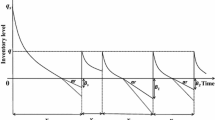Abstract
A mixture inventory system analyzed in this paper explores the problem that the lead time and ordering cost reductions are inter-dependent in a periodic review inventory model with back-order price discounts for protection interval demand with the mixture of normal distributions. The objectives of this paper are twofold. First, we want to correct and improve the recently studied model by optimizing the review period, back-order price discount, target level and lead time simultaneously to achieve significant savings in the total related cost and higher service level. Second, we consider that the demands of the different customers are not identical in the protection interval to accommodate more practical features of the real inventory systems. For the proposed model, a computational algorithm with the help of the software Mathematica 7 is furnished to derive the optimal solution. Finally, we provide numerical examples to illustrate the results.


Similar content being viewed by others
References
Bartoszewicz A, Lesniewski P (2014) Reaching law approach to the sliding mode control of periodic review inventory systems. IEEE Trans Autom Sci Eng 11(3):810–817
Ben-Daya M, Raouf A (1994) Inventory models involving lead time as decision variable. J Oper Res Soc 45:579–582
Chen CK, Chang HC, Ouyang LY (2001) A continuous review inventory model with ordering cost dependent on lead time. Inf Manag Sci 12(3):1–13
Chiu PP (1998) Economic production quantity models inventory involving lead time as a decision variable. Thesis (Ms). National Taiwan University of Science and Technology
Everitt BS, Hand DJ (1981) Finite mixture distributions. Monographs on applied probability and statistics. Chapman & Hall, London
Hariga M (1999) A stochastic inventory model with lead-time lot size interaction. Prod Plan Control 10:434–438
Hariga M, Ben-Daya M (1999) Some stochastic inventory models with deterministic variable lead time. Eur J Oper Res 113:42–51
Hayya JC, Harrison TP, He XJ (2011) The impact of stochastic lead time reduction on inventory cost under order crossover. Eur J Oper Res 211:274–281
Hoque MA, Goyal SK (2004) Some comments on inventory models with fixed and variable lead time crash costs considerations. J Oper Res Soc 55(6):674–676
Jaggi C, Ali H, Arneja N (2014) Periodic inventory model with controllable lead time where backorder rate depends on protection interval. Int J Ind Eng Comput 5(2):235–248
Lee WC (2005) Inventory model involving controllable backorder rate and variable lead time demand with the mixtures of distribution. Appl Math Comput 160:701–717
Lee WC, Wu JW, Hou WB (2004) A note on inventory model involving variable lead time with defective units for mixtures of distribution. Int J Prod Econ 89:31–44
Lee WC, Wu JW, Hsu JW (2006) Computational algorithm for inventory model with a service level constraint, lead time demand with the mixture of distributions and controllable negative exponential backorder rate. Appl Math Comput 175:1125–1138
Lee WC, Wu JW, Lei CL (2007) Computational algorithmic procedure for optimal inventory policy involving ordering cost reduction and back-order discounts when lead time demand is controllable. Appl Math Comput 189:186–200
Liao CJ, Shyu CH (1991) An analytical determination of lead time with normal demand. Int J Oper Prod Manag 11(9):72–78
Lin HJ (2012) Effective investment to reduce setup cost in a mixture inventory model involving controllable backorder rate and variable lead time with a service level constraint. Math Probl Eng. doi:10.1155/2012/689061
Lin HJ (2013) Reducing lost-sales rate on the stochastic inventory model with defective goods for the mixtures of distributions. Appl Math Model 37:3296–3306
Lin YJ (2008) Minimax distribution free procedure with backorder price discount. Int J Prod Econ 111:118–128
Montgomery DC, Bazaraa MS, Keswani AK (1973) Inventory models with a mixture of backorders and lost sales. Nav Res Logist 20:255–263
Moon I, Choi S (1998) A note on lead time and distributional assumptions in continuous review inventory models. Comput Oper Res 25(11):1007–1012
Naddor E (1966) Inventory systems. Wiley, New York
Ouyang LY, Chen CK, Chang HC (2002) Quality improvement, setup cost and lead-time reductions in lot size reorder point models with an imperfect production process. Comput Oper Res 29:1701–1717
Ouyang LY, Chuang BR, Lin YJ (2007) The inter-dependent reductions of lead time and ordering cost in periodic review inventory model with backorder price discount. Int J Inf Manag Sci 18(3):195–208
Ouyang LY, Yeh NC, Wu KS (1996) Mixture inventory model with backorders and lost sales for variable lead time. J Oper Res Soc 47(6):829–832
Paknejad MJ, Nasri F, Affisco JF (1995) Defective units in a continuous review \((s, Q)\) system. Int J Prod Res 33(10):2767–2777
Pan CH, Hsiao YC (2001) Inventory models with back-order discounts and variable lead time. Int J Syst Sci 32(7):925–929
Silver EA, Peterson R (1985) Decision systems for inventory management and production planning. Wiley, New York
Taylor BW III (1999) Introduction to management science. Prentice Hall, New Jersey
Tersine RJ (1982) Principles of inventory and materials management. North-Holland, Amsterdam
Wu JW, Lee WC, Lei CL (2009) Optimal inventory policy involving ordering cost reduction, back-order discounts, and variable lead time demand by minimax criterion. Math Probl Eng. doi:10.1155/2009/928932
Wu JW, Lee WC, Tsai HY (2007) Computational algorithmic procedure of optimal inventory policy involving a negative exponential crashing cost and variable lead demand. Appl Math Comput 184:798–808
Wu JW, Tsai HY (2001) Mixture inventory model with back orders and lost sales for variable lead time with the mixtures of normal distribution. Int J Syst Sci 32(2):259–268
Acknowledgments
The author thanks the editor and the anonymous referees for their valuable comments and suggestions. This research was supported by the Ministry of Science and Technology, Taiwan, ROC, under Grant MOST 103-2410-H-156-009.
Author information
Authors and Affiliations
Corresponding author
Rights and permissions
About this article
Cite this article
Lin, HJ. A stochastic periodic review inventory model with back-order discounts and ordering cost dependent on lead time for the mixtures of distributions. TOP 23, 386–400 (2015). https://doi.org/10.1007/s11750-014-0345-9
Received:
Accepted:
Published:
Issue Date:
DOI: https://doi.org/10.1007/s11750-014-0345-9




